After having such a great time fishing and relaxing in Florida in April, we decided to change our Christmas routine and have a few weeks away over the festive period. We had also been told that although the tarpon present at that time of year would only be small, there would be a greater variety of species as it would be between seasons. This is an added attraction as I am not an angler fixated by the size of the fish I catch, (especially as I don’t catch huge fish) but I really enjoy trying different techniques and catching a multitude of species.
Having stayed at John Rawle’s house earlier in the year, we learnt that he rents it out when he is back fishing in the UK. This was an ideal location; he had the dock at the back of the house where you can be collected from for fishing trips, and where you can fish too, as well as access to the private beach over the road onto the gulf.
We flew out on Monday 14th from Heathrow for 24 days. We parked at Purple Parking, an off airport car parking facility just off J3 of the M4 (having pre-booked on line). This is a well organised and economical way of leaving your vehicle in a safe location. When you arrive, you simply give them the key and get on a minibus that takes you to your terminal. Similarly, when you return, you call them and get collected and dropped off at you car where you are given your key to simply drive home – no fuss, effortless, and far cheaper than the extortionate Heathrow parking rates.
Having expected a BA strike to happen sometime around this period, we flew by Virgin Atlantic arriving at around 5.15pm, then had the normal hour checking through customs before getting the minibus to the car rental company. We have used Alamo on the last couple of visits, as they are well organised and seem to be competitive. Please note, I always now include extra insurance to cover the excess after having a car stolen when in Canada which ended up costing about £650, so I no longer take the chance. Again, pre book on line for the best rates, if you hire when you arrive the rates are much higher. I also hire a compact, the smallest size that is practical (you then often get an upgrade if no vehicle of that size is available).
This left the only problem being navigating Miami’s road system which isn’t as easy as it sounds, and if you stop to ask for directions, nobody speaks English. When you are driving and see road numbers overhead, these are not the identity of the road that your are on but the road that you are crossing, which takes some getting used too. We eventually found our way south and on to Route 1, which is the only road running down the keys which stretch for over 100 miles from the tip of mainland Florida, arriving at 10pm to be met by our friend Reg Talbot and his partner, Barbara, and our son Lee who had caught earlier flights.
The weather at the time was very warm with record highs being set for the period every day, so we booked Jeff Pfister of Dockland Charters to be our guide/skipper. Both Reg and I had been out with Jeff during previous visits and had great confidence in his abilities. I should point out here that we wanted to fish the flats and backwaters where the water in rarely over five feet deep stretching out for nearly 20 miles from the shoreline. Most of the species can be caught in this region apart from sailfish etc which are caught in the deeper waters over the reef. The chartering costs vary with the backwater charters being about $525 per boat for a 6 hour session. The deep sea trips start at about $1000. I prefer the backwater fishing as you are baiting, casting, hooking and playing the fish yourself which greatly increases the satisfaction. (My experience of deep sea fishing is that the baiting casting and even setting the hook is done for you, so all you become is a glorified winch, all the skill is with the skipper).
The first trip was booked for 5.30 am on the following morning. Reg and I were to fish with Barbara (Reg’s partner) coming along to see what it is all about for a couple of hours before returning to drop her off and collect Lee for four hours fishing in the backwaters. In the first period, Reg had one take from a tarpon of about 80lb plus on a pin fish which leapt four times before running through coral shallows breaking the line just above the hook.
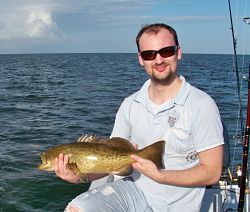
The second period took us a few miles offshore. Here we used shrimp (more prawns to us as they are about 3” long) on a hook cast out and retrieved as a lure. Initially the baited hooks with coloured heads attracted the fish most rapidly, but as the session wore on, their effectiveness decreased and a shrimp on a plain weighted hook became more effective. We caught quite a range of fish, many unexpected.
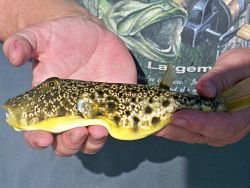
To give you an idea of the quality of the fishing I will list the range of species caught here, but won’t do it elsewhere as it would become tedious. In all we caught ladyfish, black grouper, bluefish, gray snapper, cero mackerel, spanish mackerel, hardhead catfish, remora, puffer fish, and speckled sea trout. The mackerel were kept for the barbecue and the ladyfish were taken for bait. One was sectioned and a piece put out for sharks. Towards the end of the session, the shark rod burst into life. Lee wound down and hooked into a spinner shark which Jeff estimated at over 100lb. This lived up to its name, leaping from the water as it spiralled finally biting through the leader.
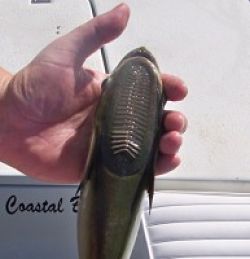
The remora was an interesting fish, sometimes known as a shark sucker, they attach themselves to larger fish by a pad on the top of their head which looks like the sole of a trainer. We put it against the side of the boat and it clung like glue. We also tried to get the puffer fish to inflate for a photograph without success; it remained a jelly like mass in your hands. This is not a fish to eat as it is highly toxic unless properly prepared by a highly trained chef. I think the meal is referred to as fugu in Japan where it is a delicacy but the chef has to be licensed to prepare it.
The days guided trip finished at about 12pm. After a lunch, Lee and I decided to fish the channel at the rear of the house, again using shrimp as bait. Lee presented his on float tackle whilst I freelined mine on my fly rod. Here the gray snapper were plentiful, but we also caught leatherjack and crevalle jack, all fought well on light tackle.
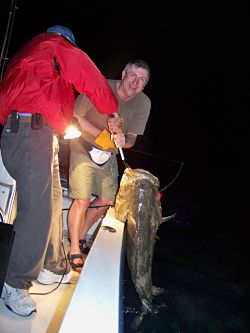
The following morning, Jeff collected us at 5am and we decided to try a different technique, trolling across the bridges between the islands up tide so that the water flow pushed our lures very close to the bridge columns. The water temperature was 77 degrees, well above the seasonal norm which kept the fish very active. Trolling in this manner is a technique for only two rods, so we rotated the rods between the three of us. Reg was first into a fish which whipped the rod over and went solid. It took a while of heaving to and fro, changing the angle of the boat until it became free. We had quickly realised it was a grouper which lock themselves into any crevices or holes available, and this was a good one, a goliath of over 80lb. This was quickly followed by another grouper for me, which again took a great deal of pulling to free even though it only weighed in at 26lb.
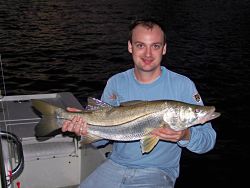
The sport continued apace with some excellent fish caught, including snook which are great eating, (but their season had finished the previous day and were returned) and barracuda. Once again, Lee hooked into a good fish, a tarpon which burnt his thumb as he had rested it on the spool, but it shed the hook. In all, we probably had more fish shed the hooks than we caught through this session even though we were trolling at a brisk pace. After 4 hours the light rose and the tide slowed, as did the sport, so we ended the session early, scheduling another for the evening when the next tide peaked and the light fell
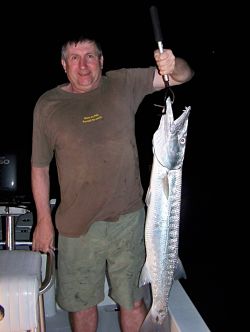
In the afternoon we fished the channel again with mixed results. I tried using a slither of fish on my fly rod. When it rested on the bottom a large stingray of nearly 3’ across its wings took the bait, flipped its wings and powered off down the channel easily smashing my line in the process. Lee had been watching barracuda, one was probably over 20lb being bigger than the ones we had caught trolling, and got one of the smaller ones to grab a chunk of spam. Once it had taken it in, Lee struck and after a few minutes the hooked pulled free; this near miss was becoming the norm for Lee.
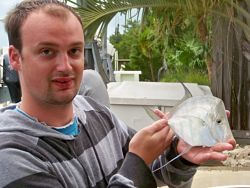
The evening session with Jeff brought about a change in the sport. As we fished we watched storms breaking in the distance, this change in barometric pressure clearly affected the fish. The fish finder was still showing shoals of fish, but they were lying low on the bottom not interested in feeding no matter how the trolling rate was changed, or which lure was used. Again, we cut this session short to save hours for better weather.
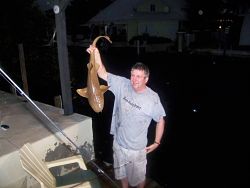
That night, we fished the channel again. Reg caught a nurse shark on a piece of fish whilst Lee hooked a good jewfish which he played with great aplomb until he brought it to the dock, where it dived under the wall locking itself in place. We were unable to move it and eventually the line parted. After everybody else has retired Lee fished on and had two powerful runs, probably from sharks. One simply overpowered him as it swam down the channel and severed the line, the second bit through the wire trace. Once again lady luck didn’t smile on Lee.
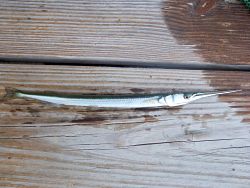
On the next day the weather front blew through which had been threatening us on the previous evening. We had 4” of rain, but this was nothing compared to other places in the Keys where up to 14” fell and three tornados struck. Through all this we continued to fish off the docks in true “mad dogs and Englishmen” style. The range of new species that we caught included sea bream, needlefish, lookdown, blue runners and schoolmaster. We also watched a large spadefish and mutton grouper swimming along the dock but were unable to arouse any interest in our bait. The range of species that were in the channel was truly amazing, and whilst some were small, there were also some very large predators which travel along these routes in the evenings.
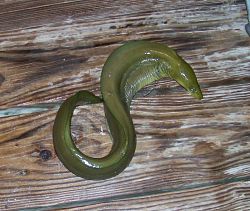
The day ended with Lee catching a moray eel off the dock. To say we didn’t fancy trying to unhook it would have been an understatement, and we were relieve to see it regurgitate the bait and hook once we lowered it onto the dock, although this was stomach churning.
From this point onwards, the weather deteriorated with cold evenings and overcast days combining with the stiff breezes. The Floridians thought that winter had finally arrived. We shocked people by wearing just shirts in the middle of this winter chill, (the temperature fell to 60 degrees), but it was like a summer day in the UK. However, the fish were used to the elevated temperatures and deserted the flats and the backwater to return to the deeper warmer water of the ocean, and the sport deteriorated dramatically for the next two weeks.
With Lee heading home after just one week, we took a trip out to the edge of the backwater on his last full day there. Jeff who, to his credit warned us that it would be uncomfortable, and the sport would be slow, and so it proved although we still both enjoyed the experience. We found that by reducing the retrieval rate of the shrimp to a crawl it was possible to encourage the fish to take, very much in the style of touch ledgering in the cold in the UK. So we managed to catch some fish, and again tried for shark on one rod. Just before we headed for home, we again had a run on the shark rod from a bluefish which Lee again lost when it bit through his line. (It was at this point that we thought about changing his name to Jonah).
That was the end of the weeks fishing with Lee and Reg, both of whom had to return to the UK. The weather in Florida continued to cool as fronts continually moved across and nights cooled driving the fish farther from the channels. Only mullet and snappers remained although as the fall in water temperature continued to fall they too ultimately disappeared. It was amazing to see the flats and backwaters devoid of all the birds that ate fish too. When we arrived they were covered in cormorants but at the end of the stay there wasn’t one to be seen.
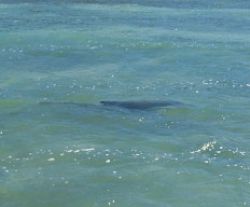
The only other fishing trip that I did was a trip on 29th with Jeff when we went out with Sandy and our youngest daughter, Jenny to use up the allocation of hours booked. This trip proved fascinating. Just out from Whale Harbor we came upon a wild porpoise which we took time out to watch, and as we went a little further, there was another pair. We then were taken around some of the mangrove islands which looked at a distance to be covered in bare branches. As we closed we realised that they were roosting pelicans and cormorants, and flying overhead were frigate birds. We took a few minutes to absorb this spectacular scene before fishing with prawns in slightly deeper channels, which only produced a sand perch, but whilst we were fishing Sandy had a wild turtle swim past on her side of the boat.
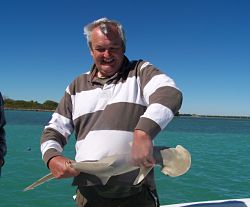
As there was clearly few fish about, we tried on the ocean side of the Keys in a channel nearing 9’ deep. Again the fishing was slow with a few twitches which we managed to encourage with gentle pulls, catching a couple of snapper and a bonnethead shark. Sandy was also excited to see a bonnethead stalking her bait, but in the excitement, drew the bait in more quickly causing the shark to shy away.
In all, the weather fronts had made the fishing much poorer than anticipated, but we were told that the weather just up the coast at Palm Beach was the coldest sustained front for 107 years, so I guess we were just unlucky. These temperature shifts were also exaggerated by the record high preceding it, causing the fish to feel more extreme change. Even so, I think we had a good range of fishing experiences, and one that I will try again.
I would also concur with and reiterate with the advice given by John Rawle prior to our departure to go for a longer period, because at that time of year there is always a chance of a front moving through although the effects generally only last for a few days. If you only go for one week this can be a significant, but over a longer period there will always be a good spell, even when the temperatures and weather are as poor as we experienced.